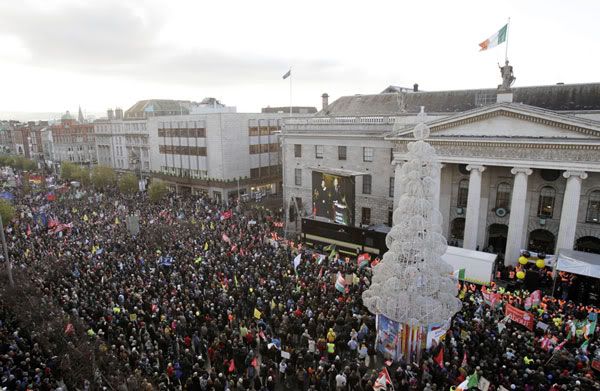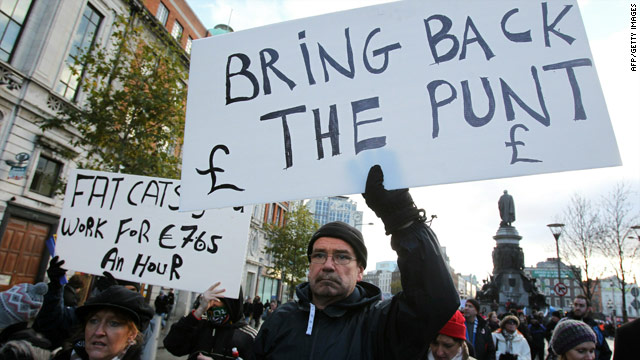
Protestors gather outside the GPO in Dublin as part of a demonstration organised by unions
against the Government's handling of the economic crisis. Photograph: Niall Carson/PA Wire
IRISH TIMES REPORTERS
Approximately 50,000 people marched in Dublin this afternoon in a protest organised by the Irish Congress of Trade Unions (Ictu) against the Government’s austerity plan.
The protest started on Wood Quay at noon, before crossing over to the north quays to Ormond Quay, continuing on to Bachelors Walk and then onto O’Connell Street, arriving at the GPO at 1pm.
Addressing the crowd on a podium at the GPO, Irish Times columnist Fintan O’Toole said the Government was doing a deal with people who had not been elected.
He said the country was paying billions to bail out the banks and the Government had declared war on the poor. He said Irish people were not subjects, but citizens, and wanted their republic back.
Ictu president Jack O'Connor told protestors the country had been brought "to its knees" by the Government and bankers.
"Several generations of Irish men and women" will have to foot the bill, Mr O'Connor said.
Congress general secretary David Begg said that Dick Turpin at least wore a mask when he robbed people. He also told the crowd that 100,000 people had joined the march, although gardaí said their estimate was 50,000.
“Does anybody in this country or in Dáil Éireann think that we can as a people afford to pay 6.7 per cent on money that we did not ask for in the first place and that is being forced upon us to bail out the banking system in Europe which is in hock to this country for €509 billion?”
Along with speeches from union leaders, some of whom were booed, musicians Christy Moore and Frances Black also performed.
Another speaker gave out what they claimed was Minister for the Environment John Gormley's home telephone number and instructed the crowd to "phone him as often as possible".
The protest ended shortly after 2pm and the majority of the crowd dispersed. A second, smaller rally then started and a crowd of several thousand people was addressed by Socialist Party MEP Joe Higgins.
Another group of about 300 protestors walked to the Dáil to continue their protest. A number of bottles and bangers were thrown at a line of gardaí blocking access to Leinster House and posters with a picture of Taoiseach Brian Cowen were set on fire.
http://www.irishtimes.com/newspaper/bre ... king3.html
=============
Protesters march through Dublin over Irish austerity plan
By the CNN Wire Staff
November 27, 2010 12:07 p.m. EST

Thousands of people march through the streets of Dublin, Ireland to protest against austerity cuts, November 27, 2010.
Dublin, Ireland (CNN) -- Tens of thousands of people demonstrated on the streets of Dublin, Ireland, on Saturday against the government's austerity plan.
Irish police estimated the number taking part in the largely peaceful demonstration to be about 50,000.
The protests were organized by the Irish Congress of Trade Unions (ICTU), which has called the four-year plan for spending cuts and tax hikes "savage and regressive."
Irish police said a comprehensive policing plan has been put in place "in order to facilitate a peaceful march." Groups of eight to 10 police officers were seen at several key intersections, monitoring the activity.
Families, pensioners, the unemployed and members of unions and community groups were among the demonstrators who braved a rare dusting of snow to come out Saturday, the ICTU said.
The marching route took protesters along the River Liffey to a Dublin landmark, the General Post Office.
Irish Prime Minister Brian Cowen announced the plan this week after agreeing to a bailout package from the International Monetary Fund and European Union, needed to tackle Ireland's massive debt.
The plan saves 10 billion euros ($13.4 billion) through welfare cuts and an additional 5 billion euros ($6.7 billion) through higher taxes. There will be reductions in the minimum wage and public-sector pay, and a hike in the value-added tax on goods and services, Cowen said.
The plan calls for introducing water meters, making students pay more for higher education, and requiring more Irish workers to pay income tax.
Trade unions complain the plan unfairly targets lower-paid workers, while making no provision for a tax on asset wealth. They say it fails to explain how the Irish people can carry the banks' massive debts and sets out no strategy for creating jobs.
"People are angry and they've had enough of this government," local journalist Juliette Gash told CNN. "They're furious because they feel like the government has handed over the keys to the country."
http://www.cnn.com/2010/WORLD/europe/11 ... index.html
======
Demonstrators in Ireland Protest Austerity Plan
By JOHN F. BURNS
Published: November 27, 2010

A demonstrator holds a picture of Prime Minister Brian Cowen of Ireland during a protest in Dublin on Saturday.
DUBLIN — After a week that brought Ireland a pledge of an $114 billion international rescue package and the toughest austerity program of any country in Europe, thousands of demonstrators took to Dublin’s streets on Saturday to protest wide cuts in the country’s welfare programs and in public-sector jobs.
The protests centered on a milelong march along the banks of the Liffey river in central Dublin to the General Post Office building on O’Connell Street, site of the battle between Irish republican rebels and British troops in the Easter Uprising in 1916 — an iconic event that many in Ireland regard as the tipping point in Ireland’s long struggle for independence.
The choice of venue for the protests by the Irish Congress of Trade Unions, coordinating the march through the city, reflected the mood of anger, dismay and recrimination in the wake of the economic shocks of the past 10 days. Those shocks have been the culmination of two years in which the Irish economy has shrunk by about 15 percent, faster than any other European economy.
Before that, Ireland enjoyed more than a decade of unprecedented prosperity, so the rescue package being worked out by the International Monetary Fund and the European Union and the austerity program the Dublin government has been forced to adopt to secure the bailout loans have come as a deep shock.
Among other things, the austerity package will involve the loss of about 25,000 public-sector jobs, equivalent to 10 percent of the government work force, as well as a four-year, $20 billion program of tax increases and spending cuts like sharp reductions in state pensions and the minimum wage. One Dublin newspaper, the Irish Independent, estimated that the cost of the measures for a typical middle-class family earning $67,000 a year would be about $5,800 a year.
The ensuing political turmoil has raised questions about the ability of the government of Prime Minister Brian Cowell to secure backing for the austerity package when it is presented to Parliament on Dec. 7. The coalition government was weakened last week by a split between the Fianna Fail party, which Mr. Cowen leads, and its main coalition partner, the Green Party, and a stunning loss by Fianna Fail in an election Friday for a parliamentary seat that reduced the government majority to two.
The peaceful and restrained nature of the protests on Saturday was one indication that the unrest may not lead to confrontations in the streets, as some have feared. On a bitterly cold day, turnout appeared to have fallen far short of the 50,000 that organizers had forecast.
Organizers had called for a “family friendly” demonstration, and that appeared to be what they got. With a police helicopter hovering overhead, speeches at the post office building drew cheers and shouts of support, and the detonation of some fireworks, but there were no reports of arrests. Protesters waved banners that depicted the austerity measures as an attack on the country’s poor, and told reporters that they feared for their futures, and the country’s.
“Everything’s collapsing,” one woman said.
“We can’t afford it,” a father with a young child said of the spending cuts. “I don’t know how we’re ever going to come out of it.”
The anger of many speakers, and among the protesters, appeared to fall about equally on the Cowen government and on the international financial institutions working out the details of the rescue package. Officials in Brussels, where European finance ministers were meeting on Saturday to discuss the package, said it could be confirmed with an announcement on Sunday.
One of the O’Connell Street speakers, typical of others, urged the country “not to allow a government with no mandate, bowing to people in Europe who are not elected, to determine our future.”
But if the government could take some encouragement from the relative quiescence of the demonstrators, its wider political prospects remained deeply uncertain. Fianna Fail’s share of the vote in the election last week, in Donegal, fell to 21 percent from 51 percent in the general election of 2007. The seat was won by Sinn Fein, a historical rival of Fianna Fail dating from the struggle for independence a century ago, but a marginal force in the republic’s politics in recent decades.
Although by-elections are regarded as unreliable bellwethers of voting patterns in general elections, the Donegal result was a further pointer to what many Irish political commentators expect to be a harsh loss for Fianna Fail in a general election that Mr. Cowen has indicated he will call for February or March.
In the meantime, the prime minister has rejected calls for his or the government’s resignation. He has said he intends to see the rescue package and the austerity program approved by Parliament before calling an election, the reverse of the pattern that Sinn Fein, among other groups, has demanded.
http://www.nytimes.com/2010/11/28/world ... ublin.html


